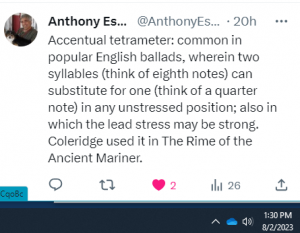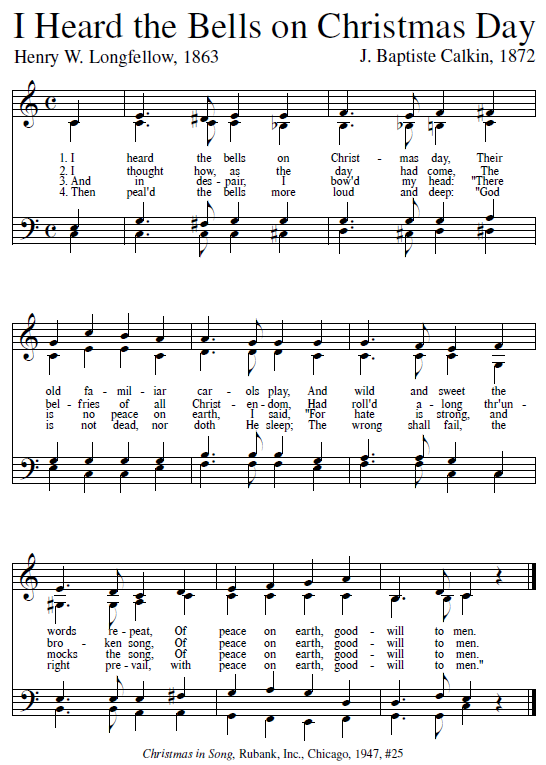
Category: Uncategorized
Jeffrey M. Ostrowski | September 22, 2022 | onepeterfive.com/english-hymns-latin-mass/
Readers surely know this adage: “The truth is stranger than fiction.” Mussolini began his career as an elementary school teacher; can you imagine sending your kindergartner to spend each day with Mussolini? Santa Anna—the enemy of the Republic of Texas at the Battle of the Alamo—later in life spent his time trying to sell rubber (for buggy tires) in New York. Can you imagine being a United States citizen in the 1850s and purchasing rubber from the guy who killed Davy Crockett? In the 1780s, Benedict Arnold’s wife lived briefly in Philadelphia with their son; can you imagine being a next-door neighbor to the wife of America’s most infamous traitor? The truth is stranger than fiction.
A ‘Trap’ For Experts
Most Catholics believe Mass used to be entirely in Latin (except Kyrie Eleison, which is Greek). Ask somebody who considers himself an expert on the Roman Rite: “What is the traditional practice for Communion at High Mass?” He will most likely reply: “It is forbidden to sing hymns in English during a High Mass; Latin alone is permitted.” Technically, this is false: cf. §14a in the document issued under Pope Pius XII on 3 September 1958. (By the way, Pius XII died a month later, on 9 October 1958, and John XXIII announced his plans to convoke Vatican II on 25 January 1959.)
But suppose your friend—while conceding that English hymns were technically allowed at High Mass—makes this assertion: “Forget what was technically allowed; I’m telling you what actually happened in the olden days.” The vexing question, therefore, would be: “What was the actual practice at High Masses during the distribution of Communion? Was it English or Latin?” The answer may surprise you. It turns out, it’s impossible to adopt the ‘traditional’ practice, because Holy Communion was seldom distributed to the faithful during Mass (roughly speaking) before the 1950s. Before your head explodes, remember: The truth is stranger than fiction. Sometimes elderly people—attempting to disparage the Missale Vetustum—declare: “I remember Low Masses so rushed they lasted 25 minutes…” But when Low Mass had no sermon and no distribution of Communion to the faithful, this is hardly the ‘death blow’ they think it is!
I could provide extensive proof—but it might cause readers to fall asleep from boredom! Therefore, I’ll keep things brief. Father Fortescue wrote in 1917: “On Maundy Thursday there is a distribution of Holy Communion at High Mass. This does not often occur on other days; but any Catholic has normally a right to present himself for Communion at any Mass, on condition that he is in a state of grace and fasting from midnight.”[1] So when exactly did Catholics receive Communion, if doing so along with the Celebrant was rare? They frequently received outside of Mass—very early in the morning—since Catholics in the olden days had to observe the “midnight fast.” For example, a 1943 parish bulletin shows that Saint Agatha’s Church (St. Louis, MO) had the distribution of Communion at 6:15am on Holy Thursday (22 April 1943) followed by a High Mass at 8:30am. The earliness of Mass times would shock many alive today—e.g. at Saint Agatha’s in 1943 the Solemn High Mass on Easter Sunday started at 5:30am! On the other hand, modern practices such as Saturday afternoon “anticipated” Masses which fulfill one’s Sunday obligation would be unthinkable to our grandparents.
Peculiar Practices
In addition to Communion being distributed outside of Mass, the American Ecclesiastical Review,[2] describes yet another practice—common then, but astonishing to us in the year 2022—in which an assistant priest would begin distribution of Communion immediately after the Consecration. Speaking of practices which might strike us as ‘bonkers,’ we should remember that during Low Mass, the congregation often sang English hymns the entire time (even while the Celebrant was quietly reading the Gospel, Creed, Canon, and Last Gospel). This is proven beyond a shadow of a doubt by old Catholic hymnals: “Mass Hymns” (Fr. Thomas Seed, 1906); “Book of Catholic Hymns” (Fr. Gregory Ould, 1910); “Holy Cross Hymnal” (Cardinal O’Connell, 1915); the 1958 “New Saint Basil Hymnal” (cf. numbers 203-210); and so forth.
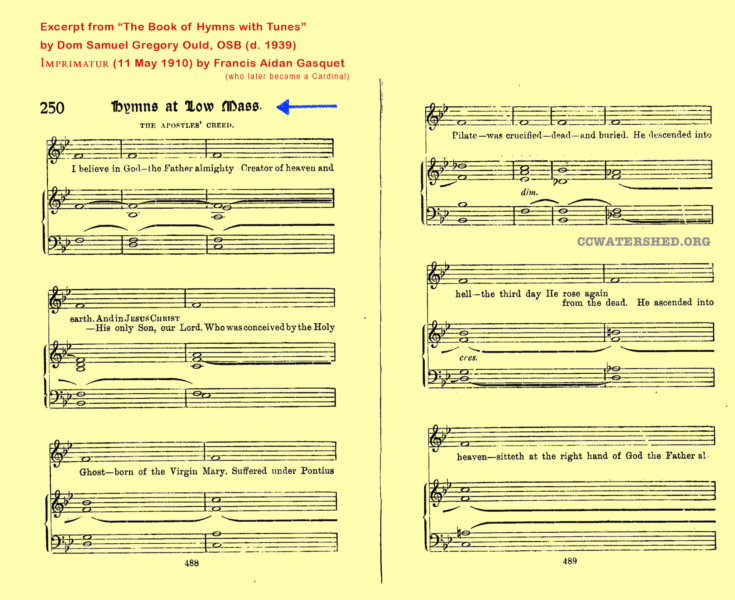
“Altogether Unbecoming”
A significant change happened when the Code of Rubrics was issued in 1961. Specifically, §502 declared: “The proper time to distribute Holy Communion to the faithful is during Mass, after the Communion of the Celebrant… It is altogether unbecoming for another priest to distribute Holy Communion—other than at the proper time for Communion—at the same altar at which Mass is actually being celebrated.” But Communion outside of Mass was still permitted “for a reasonable cause,” and Father Henry Dziadosz suggested (15 December 1960) that “relieving the congestion” might justify this.
We can see that it’s fallacious to ask whether it was ‘traditional’ to sing English hymns during Communion at High Mass in the olden days. That would be like asking how farmers in the 1700s charged their iPhones. The reality is, smart phones did not exist in the 1700s. Similarly, Communion was not—broadly speaking—given to the faithful at High Mass before the 1950s (the decade in which Pius XII eliminated the “midnight Eucharistic fast”). Indeed, throughout history we observe a variety of customs vis-à-vis the distribution of Holy Communion; e.g. Bishop Urban Sagstetter (d. 1573) mandated Communion songs in the vernacular in his diocese. Particularly in German-speaking countries, vernacular hymnody at the High Mass was routine, including items Americans would find peculiar (e.g. the “sermon hymn”).
Nothing forbids the singing of vernacular hymnody during Communion for the Latin Mass. Those who desire authentic, orthodox, superb hymns for Holy Communion should pick up a copy of The Saint Jean de Brébeuf Hymnal. This new pew book contains wonderful ‘traditional’ hymns such as the following (“Rex Sempiterne” translated to English by Archbishop Bagshawe):
It also contains newly-composed hymns, such as the following (by Father Dominic Popplewell, FSSP):
I could not run my musical program without the magnificent hymns in the Brébeuf Hymnal. Of course, we also sing Renaissance polyphony, Gregorian Chant, Baroque compositions, and medieval music. My organization produced a Gregorian Chant website which have received more than 12 million visitors: Saint René Goupil Chant. We have also produced an impressive polyphony page: Lalemant Polyphonic. We promote elegant compositions by living composers, and choir members love to sing these contemporary pieces over and over. Nevertheless, Catholic hymnody continues to be an essential part of our repertoire, and the Brébeuf hymnal does not mimic or ‘build upon’ Protestant models. One of the main authors for the Church Music Association of America weblog said recently (10 June 2022) that when it comes to Catholic hymns, the Brébeuf Hymnal “has no parallel and not even any close competitor.”
1 Father Adrian Fortescue, Ceremonies of the Roman Rite Described (London: Burns & Oates, 1918), 130.
2 American Ecclesiastical Review (1955), vol. CXXV, 66.
Jeffrey M. Ostrowski
Jeffrey M. Ostrowski holds his B.M. in Music Theory from the University of Kansas (2004) and has done graduate work in the fields of Musicology and Education. Is the president of Watershed and his writings have appeared in Homiletic & Pastoral Review, Sacred Music Journal, The Catholic Exchange, New Liturgical Movement, Liturgical Arts Journal, Adoremus Bulletin. He currently serves as choirmaster for the new FSSP Apostolate in Los Angeles, CA, where he lives with his wife and children. Known across the globe as a composer, before he had reached the age of 30, Mr. Ostrowski’s compositions had already been sung by distinguished choirs—e.g. the resident choir of the New York Philharmonic—as well as for Masses in major churches such as Saint Peter’s Basilica (Vatican City)
Ave Maria
J.S. Bach / Charles Gounod
It is my fondest wish for Katie Jean that when she closes her eyes, she opens them on the face of this Woman.

This shortlink
http://www.sing-prayer.org/p/2870
We respectfully submit all inquiries about matters of permissible theological speculation to duly constituted, Catholic authority of the ages, especially under the auspices of local congregations of the usus antiquior.
This is to distinguish the normal human impulse to exercise of the will, intrinsic to human nature, from the vice of pride, the original vice in the hierarchy of vices.
| Vice | Latin | Virtue | Latin |
|---|---|---|---|
| Lust | Luxuria | Chastity | Castitas |
| Gluttony | Gula | Temperance | Moderatio |
| Greed | Avaritia | Charity (Generosity) | Caritas (Liberalitas) |
| Sloth | Acedia | Diligence | Industria |
| Wrath | Ira | Patience | Patientia |
| Envy | Invidia | Gratitude | Gratia |
| Pride | Superbia | Humility | Humilitas |
It seems that the Church teaches that, while in God it may be that in His ultimate simplicity, will and intellect are not fundamentally distinguished, from the perspective of created spiritual beings, intellect and will are to be distinguished. This is known from the catechetical formulation, that our original parents’ fall from grace was characterized by residual darkening of the intellect and weakening of the will.
An illustration from orthodox philosophy seems to clarify the issue of distinctions among the intellect, the will and the passions.
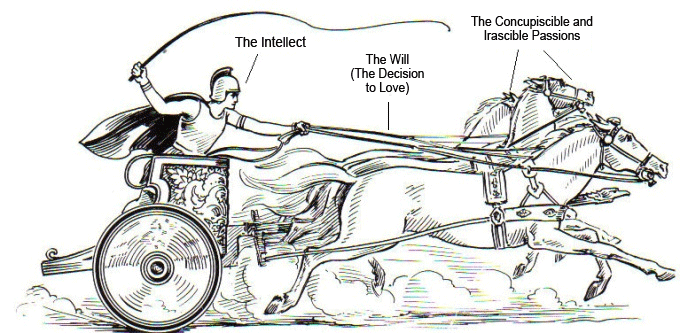
The charioteer represents the intellect, the reins represent the will, the horses represent the passions.
A representation of the passions is useful.
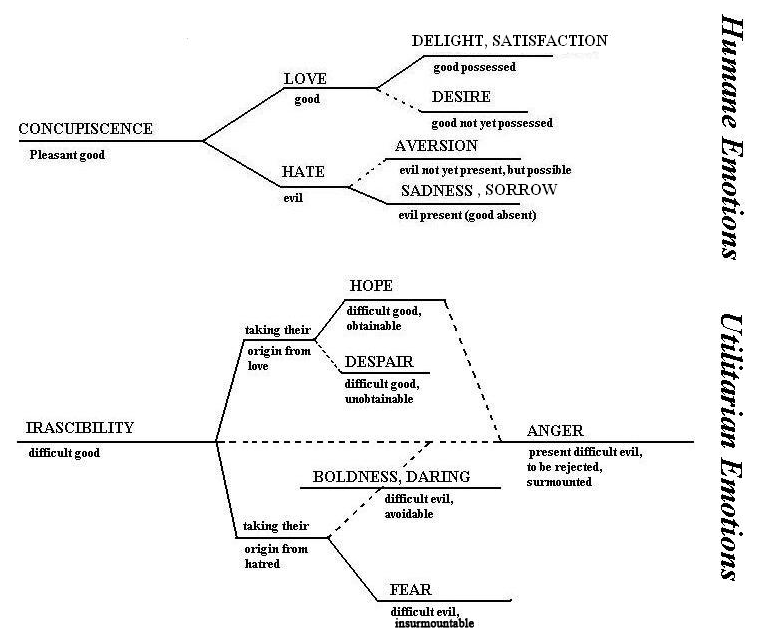
This short-link
sing-prayer.org/p/2841
Pro-life professional advertising psychology research, the bright side of otherwise nefarious “engineering of consent” industry, revealed by 1998 that the standard pro-life approach to women in crisis pregnancies has consistently continued to be largely self-defeating because it fails to account for crisis-pregnancy Mothers’ actual psychological state. Dr. Carl Landwehr, the man most single-handedly responsible for tipping the majority, if not the elites of America pro-life, speaks about “the dogma dump” — if I could just open a hatch in their heads and make them understand what I know, they would convert to my viewpoint and everything would become alright. We couldn’t afford that approach then, and as long as we are opposed by wealthy elites, we will continue to experience failure saving babies and Mothers, as the opposition continues its relentless innovations in convincing young people to the pro-abortion side.
Abortion: A Failure to Communicate by Paul F. Swope, First Things, April 1998 https://tinyurl.com/4kn2swwt
For twenty-five years the pro-life movement has stood up to defend perhaps the most crucial principle in any civilized society, namely, the sanctity and value of every human life. However, neither the profundity and scale of the cause, nor the integrity of those who work to support it, necessarily translates into effective action. Recent research on the psychology of pro-choice women offers insight into why the pro-life movement has not been as effective as it might have been in persuading women to choose life; it also offers opportunities to improve dramatically the scope and influence of the pro-life message, particularly among women of childbearing age.
Unplanned motherhood … is perceived as equivalent to a “death of self.” … the choice of abortion becomes one of self-preservation. … Adoption is seen as the most “evil” of the 3 options … as a kind of double death. … The 2nd death is the death of the child “through abandonment.” A woman worries about the chance of her child being abused … the possibility of the child returning to intrude on her own life many years later.
This research suggests that modern American women of childbearing age do not view the abortion issue within the same moral framework as those of us who are pro-life activists. Our message is not being well-received by this audience because we have made the error of assuming that women, especially those facing the trauma of an unplanned pregnancy, will respond to principles we see as self-evident within our own moral framework, and we have presented our arguments accordingly. This is a miscalculation that has fatally handicapped the pro-life cause. While we may not agree with how women currently evaluate this issue, the importance of our mission and the imperative to be effective demand that we listen, that we understand, and that we respond to the actual concerns of women who are most likely to choose abortion.
The importance of a new approach became clear from the results of sophisticated research pioneered by the Caring Foundation, a group that presents the pro-life message to the public via television. This group has been able to tap into some of the most advanced psychological research available today, so-called “right brain” research. (The distinction between “right brain” and “left brain” activity may be physiologically oversimplified or even wrong, but it remains useful as a shorthand description of different ways of thinking.)

Click the ▶ Button to hear the talk, or hear the talk in a New Window ⧉
The Four Levels of Happiness
Philomena (2 years old) sings in a deep voice, and when she walks, she swings her elbows like a sailor walking on a swaying ship deck. (What a character.) This key, which her makes her grandpa sound like a pirate singing, is 5 half-steps high or 7 half-steps low, from the traditional key. Only the Men’s part is offered here.
Click the ▶ Button to sing the carol (key for Men), or play the carol in a New Window ⧉
| Deck the halls with boughs of holly, | ‘Tis the season to be jolly, |
|
Fa la la la la la la la! |
|
| Don we now our gay apparel, | Troll the ancient Yuletide carol, |
|
|
|
| See the blazing yule before us, | Strike the harp and join the chorus, |
|
Fa la la la la la la la! |
|
| Follow me in merry measure, | While I tell of Yuletide treasure, |
|
|
|
| Fast away the old year passes, | Hail the new, ye lads and lasses, |
|
Fa la la la la la la la! |
|
| Sing we joyous all together! | Heedless of the wind and weather, |
|
|
|
| Deck the halls with boughs of holly, | ‘Tis the season to be jolly, |
|
Fa la la la la la la la! |
|
| Don we now our gay apparel, | Troll the ancient Yuletide carol, |

I attended the gold or silver anniversary of a seminary and novitiate, which was a large, informal garden party attended by all the diocesan luminaries. My wife and I were photographed in the vicinity of the Bishop, though were aren’t sufficiently important for him to have anything to say to us.
During the party, a jazz piece was playing repeatedly, which took God’s name in vain. It was the 1969 Les McCann and Eddie Harris “Trying to Make It Real” (Compared to What?). At the rhythmic and dynamic climax of the piece, the singer suddenly curses God.
This piece repeated twice at the religious garden party, and yet, with the presence of all the high officials of religious institutes and offices, no one recognized the fact.
When I brought it up with the responsible official, the rector of the novitiate and seminary, who is also a commentator on a national radio show, his rationale was that “we used a jazz playlist of a streaming music service, and sadly it never even occurred to me that I would even have to worry about such language being used.”
I was confronted by an identical rationale for repeated playing in the presence of a child, of a sexually suggestive piece, Ray Charles’ “It’s Alright”. At the emotional highlight of the piece, the women backup singers make sexually suggestive moaning, in rhythm, even using the rhythmic technique “diminution”, shortening duration of the sexual moaning in half. This is particularly unfortunate, considering the reputation that the Raelettes’ backgroup were required to sexually submit to Ray Charles as conditions of employment. (Ray Charles: Women in His Life | Entertainment Magazine)
Several comments are in order about exposing ourselves to Rhythm and Blues and Jazz music in our everyday lives. Jazz has a mixed moral history, on one hand, in its origins were religious, in one time and place, while an elaborate funeral parade was playing sad music on the way to the graveyard, on the way back, triumphal music would be played, this as one account of the origin of Jazz as a genre.
On the other hand, the etymology of Jazz in the Swahili tongue, is supposed to mean sexual arousal. (This affects the legitimacy of the annual, Memorial Day, “Jazz Mass” at Sacramento’s Cathedral of the Blessed Sacrament.)
The practical rearing of Jazz as a genre, occurred in clubs and roadhouses that served as de facto bordellos. It isn’t any secret, when listening to a Jazz radio station, that much of the music has a morally low tone.
It is supposed in Plato’s Republic, that certain rhythmic and melodic modes can contribute to dissolute morals.
Regardless, it is up to individuals to overcome the dulling, hypnotizing potential of music, to be alert to the morality of what is actually being conveyed.
Everyone used to sing. Today, we are in a culturally crippled condition, dependent on technologic devices to the point of debilitation. But worse, we are almost completely unaware of the problem.
In the 1960s, it resulted in an associate of Monsignor Anabele Bugnini, Dominican Arch-Abbott and later Archbishop of Minneapolis-St. Paul, the benighted Rembert Weakland, initiating the “Hootenanny Mass” movement, though he himself was highly trained both in modern art music (it can be argued, “classical” only covers one period in the range), and also Gregorian Plainchant.
The young people who were corrupted by this development, were rendered culturally defenseless by having lost their direct experience making music themselves–not necessarily as specialist, instrumentalists, but just as ordinary, casual, folk and popular music singers–the condition that two generations prior, had been the norm, stretching back into the dawn of folk-music history–in all cultures, worldwide.

We are actually worse-off than the residents of Sanliurfa, Turkey, who have the advantage unknown to us, that they can at least see a mysterious mound, Gobekli Tepe, which upon some archeological chance was revealed to be site of the oldest civilization known in human history, 9,000 B.C. The excavations are revealing a completely unknown culture, because there is apparently no reference to the site on any ancient monuments or in the Bible.

Our more ignorant condition, about our own cultural ancestry and heritage, is worse, because we lack even a view of the ruins; and yet the people who lived that culture, may perhaps have been known by name, to our grandparents. The cultural snow-blindness, of cell-phones, computers, t.v. and broadcast music, completely obliviates any understanding of a past only 100 years old.
“Everyone knew how to sing 200 songs”. – John Senior
In the video, cheap-crook Richard Widmark assumes that a bartender knows, to be able to sing extemporaneously, any random, popular song, in this case, “Camptown Races”. There was nothing exceptional about this portrayal; everyone liked music, there was no radio or talkies, everyone casually sang songs as part of their normal cultural lives. It was never remarked upon, as merely a normal part of life, and so, that cultural milieu has gone into a kind of social archeology, ruins in time as mysterious and unknown as unidentified mounds on the Anatolian plains.
Detective Dale Robertson finds a pencil holder at the scene of the murder-robbery of a somewhat wealthy hotel resident.

(From a time before the invention of the ball-point pen, it wasn’t practical to carry fountain pens on one’s person, they would leak and ruin your suite. Lead pencils were routinely carried in one’s suit jacket; it was common to observe someone licking the lead before writing, because the natural, metallic lead was too hard and smooth, it was difficult to get traction to get the pencil to write darkly enough. As a pencil would get worn down through use and sharpening down, the pocket of the common man would be liable to contain a metal tube-extender/container for the pencil stub: a pencil holder.)
The pencil holder Detective Robertson finds, at the site of the hotel murder, is inscribed with the legend “Camptown Races”. As he holds the crucial evidence, identifying the murderer, he takes an identical pencil holder, inscribed with the same motto, out of his own pocket.
The inscribed pencil holders were part of a set of four, won by participants in a singing competition at a county fair. The cop, Robertson, had one of the four, matching prizes; the murderer, Widmark, part of the same, prize-winning, informal song contest ensemble, had another, having left it at the scene of the crime.
Robertson having been at one time an employee of a private business, had taken some money, in what is called embezzlement or larceny, with the intention of making a quick profit, and putting back the original capital, $1,000.
When he lost the money, he had to go to his cheap-crook friend, Richard Widmark, who would be revealed, years later, as the murderer. Widmark habitually insults people in public; one of his unfortunate choice of victims, turns out to be a newspaper publisher.
As Robertson tries to collar Widmark, he is prevented, in honor, by the favor that Widmark had done to him when he, now the detective, had then been the civilian employee afoul of the law. Robertson can’t arrest Widmark, because he owes him in exchange for the $1,000 Widmark gave Robertson, to get him out of trouble for his larceny/embezzlement.
The cop, Robertson, figures out how to escape his moral compromise: he goes to the publisher whom the crook had insulted, asks for an advance on reward money for the murder, it is granted, because the publisher is willing to risk that much to put away the man who insulted him.
Robertson, relieved of the moral compromise, now makes the arrest, after a desperate fight scene on a train about to depart for Chicago.
In the bar scene, as Widmark insults the bartender into joining in a trio of the title song, “Camptown Races”, the movie gives corroboration of John Senior’s assertion, that everyone knew how to sing 200 songs. Widmark is able to assume that the bartender can sing Camptown Races, without any preparation; the improvisatory result is ample evidence, that people once sang.
“I was looking at one of those American classics that most of us studied in high school, “The Midnight Ride of Paul Revere.” How wonderful this is–a meter that captures a horse’s gallop. Longfellow was a good writer, telling a great story in a magical way, and he pulled this off. I bet most people assume it’s a standard poetic form of some kind. However, when I looked at it closely and counted syllables, I realized Longfellow mixed up his lines and endlessly created variations on his metrical scheme. A lesser talent, following the same rules more tightly, might make us bonkers by the 20th line. Longfellow managed to achieve a kind of beautiful roughness that is a metaphor for this country.” – Bruce Deitrick Price, The ‘Rules’ of Poetry—Says Who?
Another Longfellow poem with rhythmic complexity (departure from standard, rhythmic regularity) is the Three Kings, rendered here in an experimental format “artificially regular”.

Click the ▶ Button to Hear the Song, or Play the Song in a New Window ⧉
| Henry Wadsworth Longfellow | Sir John Stainer |
|---|---|
| 1) Three Kings came riding from far away, Melchior and Gaspar and Baltasar; Three Wise Men out of the East were they, And they travelled by night and they slept by day, For their guide was a beautiful, wonderful star. |
2) The star was so beautiful, large and clear, That all the other stars of the sky Became a white mist in the atmosphere, And by this they knew that the coming was near Of the Prince foretold in the prophecy. |
| 3) Three caskets they bore on their saddle-bows, Three caskets of gold with golden keys; Their robes were of crimson silk with rows Of bells, pomegranates and furbelows, Their turbans like blossoming almond-trees. |
4) And so the Three Kings rode into the West, Through the dusk of the night, over hill & dell, & sometimes they nodded with beard on breast, And sometimes talked, as they paused to rest, With the people they met at some wayside well. |
| 5) “Of the child that is born,” said Baltasar, “Good people, I pray you, tell us the news; For we in the East have seen his star, And have ridden fast, and have ridden far, To find and worship the King of the Jews.” |
6) And the people answered, “You ask in vain; We know of no King but Herod the Great!” They thought the Wise Men were men insane, As they spurred their horses across the plain, Like riders in haste, who cannot wait. |
| 7) And when they came to Jerusalem, Herod the Great, who had heard this thing, Sent for the Wise Men and questioned them; And said, “Go down unto Bethlehem, And bring me tidings of this new king.” |
8) So they rode away; and the star stood still, The only one in the grey of morn; Yes, it stopped—it stood still of its own free will, Right over Bethlehem on the hill, The city of David, where Christ was born. |
| 9) And the Three Kings rode through the gate and the guard, Through the silent street, till their horses turned And neighed as they entered the great inn-yard; But the windows were closed, and the doors were barred, And only a light in the stable burned. |
10) And cradled there in the scented hay, In the air made sweet by the breath of kine, The little child in the manger lay, The child, that would be king one day Of a kingdom not human, but divine. |
| 11) His mother Mary of Nazareth Sat watching beside his place of rest, Watching the even flow of his breath, For the joy of life and the terror of death Were mingled together in her breast. |
12) They laid their offerings at his feet: The gold was their tribute to a King, The frankincense, with its odor sweet, Was for the Priest, the Paraclete, The myrrh for the body’s burying. |
| 13) And the mother wondered and bowed her head, And sat as still as a statue of stone, Her heart was troubled yet comforted, Remembering what the Angel had said Of an endless reign and of David’s throne. |
14) Then the Kings rode out of the city gate, With a clatter of hoofs in proud array; But they went not back to Herod the Great, For they knew his malice and feared his hate, And returned to their homes by another way. |
|
I
|
09-10-09-11-12 |
VIII
|
10-09-11-09-10 | |
|
II
|
10-09-10-11-10 |
IX
|
11-10-10-11-10 | |
|
III
|
10-09-09-11-10 |
X
|
09-10-09-08-10 | |
|
IV
|
10-11-10-09-11 |
XI
|
09-09-09-11-09 | |
|
V
|
10-10-09-10-10 |
XII
|
09-09-09-08-09 | |
|
VI
|
10-10-09-10-09 |
XIII
|
10-10-09-10-10 | |
|
VII
|
09-09-09-09-09 |
XIV
|
10-10-10-10-11 |
| Henry W. Longfellow, 1863 | J. Baptiste Calkin, 1872 Waltham |
|---|---|
| 1. I heard the bells on Christmas Day Their old, familiar carols play, And wild and sweet The words repeat Of peace on earth, good-will to men! |
2. And thought how, as the day had come, The belfries of all Christendom Had rolled along The unbroken song Of peace on earth, good-will to men! |
| 3. Till ringing, singing on its way, The world revolved from night to day, A voice, a chime, A chant sublime Of peace on earth, good-will to men! |
4. Then from each black, accursed mouth The cannon thundered in the South, And with the sound The carols drowned Of peace on earth, good-will to men! |
| 5. It was as if an earthquake rent The hearth-stones of a continent, And made forlorn The households born Of peace on earth, good-will to men! |
6. And in despair I bowed my head; “There is no peace on earth,” I said; For hate is strong, And mocks the song Of peace on earth, good-will to men!” |
| 7. Then pealed the bells more loud and deep: “God is not dead, nor doth He sleep; The Wrong shall fail, The Right prevail, With peace on earth, good-will to men.” |
